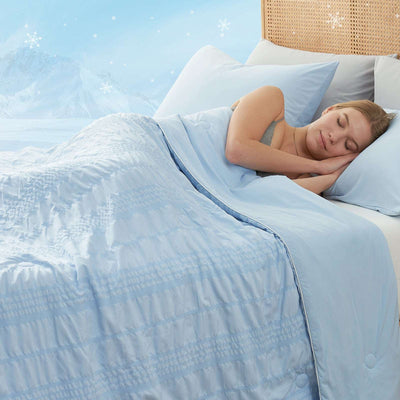Unlock the Secret to a Cool Night's Sleep with the Perfect Comforter!
Getting a good night's sleep is essential for overall health and well-being. One of the crucial factors that can significantly affect sleep quality is temperature. Many people struggle with staying cool during warmer months, which can lead to restless nights and groggy mornings. This is where the right comforter comes into play. Comforters that keep you cool can be a game-changer, especially for those living in hot climates or experiencing heat waves. In this article, we will explore various types of comforters designed to maintain a cool sleeping environment, ensuring you wake up refreshed and ready to tackle the day ahead.

Understanding the Science of Sleep Temperature
Body temperature plays a vital role in regulating sleep quality. According to sleep experts, the ideal sleep temperature for most individuals lies between 60°F and 67°F (15°C to 19°C). When you sleep, your body naturally cools down, and if your bedding is too warm, it can disrupt this process, leading to discomfort and poor sleep quality. The physiological reasons behind this include the body’s need to lower its core temperature to initiate sleep and maintain deep sleep cycles. A cool sleeping environment can help facilitate this, allowing for uninterrupted rest and rejuvenation. By choosing comforters with cooling properties, you can create a sleep sanctuary that promotes relaxation and deep restorative sleep.
Types of Comforters that Keep You Cool
When it comes to cool comforters, various materials and technologies can help regulate your body temperature. Look for options made from breathable fabrics that allow for adequate airflow, such as cotton, linen, and bamboo. These materials wick away moisture and heat, keeping you comfortable throughout the night. Additionally, some modern comforters feature advanced technologies, such as moisture-wicking properties and cooling gel infusions that actively draw heat away from your body. These innovations work to create a more comfortable sleep experience, ensuring you stay cool even on the hottest nights. Whether you prefer the natural feel of cotton or the advanced technology of cooling gels, there are numerous options available to suit your needs.
Natural Fibers vs. Synthetic Options
When comparing natural fibers to synthetic options, both have their unique benefits and drawbacks. Natural fibers, like cotton and bamboo, are known for their breathability and moisture-wicking capabilities. They can help regulate temperature naturally, making them an excellent choice for those looking for comforters that keep you cool. However, they may require more care to maintain their quality over time. On the other hand, synthetic materials like polyester and nylon often come with moisture-wicking properties as well but may not be as breathable as their natural counterparts. They tend to be more durable and easier to care for, but some individuals may find them less comfortable due to their tendency to trap heat. Ultimately, the choice between natural and synthetic will depend on personal preferences and priorities.
Choosing the Right Comforter: Factors to Consider
When selecting a cooling comforter, there are several factors to consider. First, think about the weight of the comforter; lighter options tend to promote better airflow and are often cooler. The loft and fill power are also essential as they affect the comforter's ability to trap air and regulate temperature. A higher fill power typically indicates better insulation, but it may not always equate to cooler sleep. Additionally, consider the care instructions, as some materials require special handling, while others are machine washable and easy to maintain. By weighing these factors, you can choose a comforter that not only keeps you cool but also fits your lifestyle.
Price Range and Value for Money
The price of cooling comforters can vary significantly based on materials, technology, and brand. While budget options are available, investing in a quality comforter can yield better long-term benefits due to durability and performance. Generally, you can find cooling comforters ranging from affordable to premium prices. When assessing value for money, consider factors like the comforter's lifespan, ease of care, and how well it meets your cooling needs. A more expensive comforter might save you money in the long run by providing excellent cooling properties and lasting durability.
Choosing the Ideal Comforter for Cool Sleep
Choosing the right comforter for a cool night's sleep is essential for enhancing your sleep quality and overall well-being. From understanding the science of sleep temperature to exploring the various types of comforters available, it's crucial to take into account your personal sleep needs and preferences. By considering factors such as materials, weight, and price, you can find a comforter that not only keeps you cool but also ensures restful and rejuvenating nights. Remember, a great comforter is an investment in your sleep, and ultimately, in your health.








